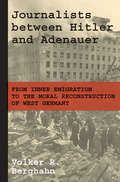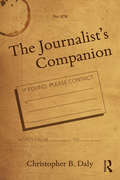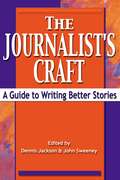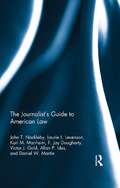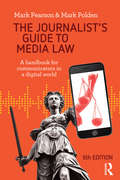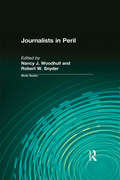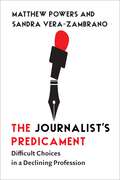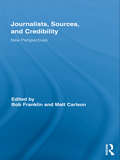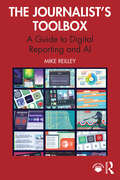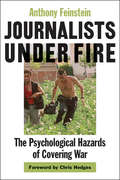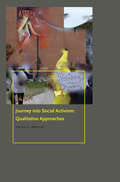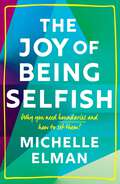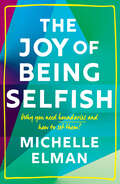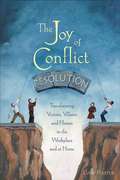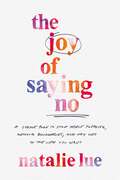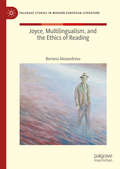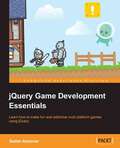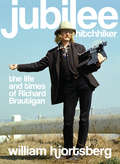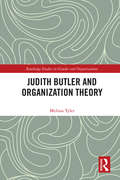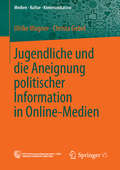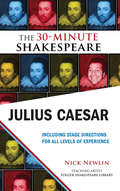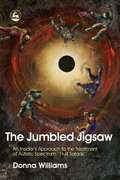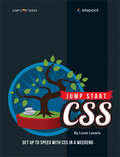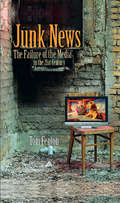- Table View
- List View
Journalists between Hitler and Adenauer: From Inner Emigration to the Moral Reconstruction of West Germany
by Volker R. BerghahnThe moral and political role of German journalists before, during, and after the Nazi dictatorshipJournalists between Hitler and Adenauer takes an in-depth look at German journalism from the late Weimar period through the postwar decades. Illuminating the roles played by journalists in the media metropolis of Hamburg, Volker Berghahn focuses on the lives and work of three remarkable individuals: Marion Countess Dönhoff, distinguished editor of Die Zeit; Paul Sethe, “the grand old man of West German journalism”; and Hans Zehrer, editor in chief of Die Welt.All born before 1914, Dönhoff, Sethe, and Zehrer witnessed the Weimar Republic’s end and opposed Hitler. When the latter seized power in 1933, they were, like their fellow Germans, confronted with the difficult choice of entering exile, becoming part of the active resistance, or joining the Nazi Party. Instead, they followed a fourth path—“inner emigration”—psychologically distancing themselves from the regime, their writing falling into a gray zone between grudging collaboration and active resistance. During the war, Dönhoff and Sethe had links to the 1944 conspiracy to kill Hitler, while Zehrer remained out of sight on a North Sea island. In the decades after 1945, all three became major figures in the West German media. Berghahn considers how these journalists and those who chose inner emigration interpreted Germany’s horrific past and how they helped to morally and politically shape the reconstruction of the country.With fresh archival materials, Journalists between Hitler and Adenauer sheds essential light on the influential position of the German media in the mid-twentieth century and raises questions about modern journalism that remain topical today.
The Journalist's Companion
by Christopher B. DalyThe Journalist’s Companion is the book for every journalist and journalism student’s coat pocket or backpack. Anchored by an annotated copy of the U.S. Constitution, this slim and portable volume provides guidance, inspiration, and practical advice for being a journalist today. A veteran front-line news reporter and professor of journalism for another twenty years, Christopher B. Daly has seen the attempts to silence and intimidate journalists. The Journalist’s Companion gives reporters, editors, and students the inspiration to stand tall along with advice to do their work well, accurately, and fearlessly. This book also includes a brief guide on how to file a Freedom of Information Act demand, a checklist for reporters and editors designed to increase the level of accuracy in their work, a primer on copyright and professional courtesy, and a quick guide to staying safe while on assignment.
The Journalist's Craft: A Guide to Writing Better Stories
by Dennis Jackson John SweeneyThis inspiring collection of 19 essays from veteran news writers explains how to weave storytelling skills into nonfiction narratives. Journalists of all backgrounds and levels of experience will discover dozens of exercises that have been tested successfully in newsrooms, workshops, and classrooms, and will cover everything from the fundamentals of reporting, writing and revising to more specialized elements like creating rhythm, cadence, and voice; employing dialogue and scene-building; and such devices as foreshadowing, symbols, and metaphors. Contributors are all veteran journalists, including Mark Bowden, author of Black Hawk Down, and several Pulitzer Prize-winners.
The Journalist's Guide to American Law
by John T. Nockleby Laurie L. Levenson Karl M. Manheim F. Jay Dougherty Victor J. Gold Allan Ides Daniel W. MartinThis easy-to-use guidebook offers an overview of American law that should find a place on the desk of any journalism student or professional journalist. The Journalist’s Guide to American Law provides an overview of major legal principles and issues in practical terms for journalists covering any aspect of the legal system. The book’s organization captures both the bird’s-eye view of the subject and offers an easy reference guide when the professional needs to understand a distinct legal concept. The areas covered range from professional concerns such as the First Amendment, cameras in the courtroom, Sunshine laws, and access to government documents to general legal matters such as the institutions of law and the lawmaking function of the judiciary, core constitutional principles such as separation of powers and judicial review, and the day-to-day functioning of courts. Equally at home on the desk of the general assignment reporter or the legal correspondent, as well as their producers and editors, the book equips the journalist with the knowledge required to translate complex legal notions into plain English.
The Journalist's Guide to Media Law: A handbook for communicators in a digital world
by Mark Polden Mark PearsonWe are all journalists and publishers now: at the touch of a button we can send our words, sounds and images out to the world. No matter whether you're a traditional journalist, a blogger, a public relations practitioner or a social media editor, everything you publish or broadcast is subject to the law. But which law?This widely used practical guide to communication law is essential reading for anyone who writes or broadcasts professionally, whether in journalism or strategic communication. It offers a mindful approach to assessing media law risks so practitioners can navigate legal and ethical barriers to publishing in mainstream and social media.This sixth edition has been substantially revised to reflect recent developments in litigation, and the impact of national security laws and the rising gig economy where graduates might work in the news media, PR, new media start-ups, or as freelancers. It covers defamation, contempt, confidentiality, privacy, trespass, intellectual property, and ethical regulation, as well as the special challenges of commenting on criminal allegations and trials. Recent cases and examples from social media, journalism and public relations are used to illustrate key points and new developments. Whether you work in a news room, in public relations or marketing, or blog from home, make sure you have The Journalist's Guide to Media Law at your side.'Whether you're an MSM editor or reporter, a blogger, a tweeter or a personal brand, this book might save your bacon.' - Jonathan Holmes, former ABC Media Watch host'The leading text book from which most journos learned their law' - Margaret Simons, associate professor in journalism, Monash University
Journalists in Peril
by Nancy J. Woodhull Robert W. SnyderThreats to journalists carry many different lessons, but one is constant: People who would intimidate or kill journalists are usually terrified that someone might find out. Journalists who want to protect one another need do nothing more than what should come naturally to them: report on threats to journalists--big threats and small threats, whether they are directed against the international luminaries of the profession or small timers. Non-journalists can also play a big part in the fight to protect journalists. Next to tough and timely reporting that establishes the facts of a case, nothing protects a journalist so much as public outrage and public support. Ordinary citizens can play an enormous role by pressuring thugs and tyrants who would like to stifle the freedom of the press. The freedom of journalists is consequently the bedrock of freedom for all people. Chapters and contributors to 'Journalists in Peril' include: "The Clash of Arms in Exotic Locales" by Peter Arnett; "Press Freedom--Balkan Style" by Kati Marton; "Grim Prospects for Hong Kong" by John Schidlovsky; "Russian Reporters--Between a Hammer and an Anvil" by losif M. Dzyaloshinsky; "Defiant Publishing in Nigeria" by Dapo Olorunyomi; "Turkish Journalists on Trial" by Ahmet Emin; "In America, Justice for Some" by Ana Arana; and "Blood and Fear in Italy" by Candida Curzi. The tragic accounts detailed in 'Journalists in Peril' are poignantly written and are important reading for all concerned with democracy in the world, especially political scientists, government officials, and those involved in the various communications professions.
The Journalist's Predicament: Difficult Choices in a Declining Profession
by Matthew Powers Sandra Vera-ZambranoLow pay. Uncertain work prospects. Diminished prestige. Why would anyone still want be a journalist? Drawing on in-depth interviews in France and the United States, Matthew Powers and Sandra Vera-Zambrano explore the ways individuals come to believe that journalism is a worthy pursuit—and how that conviction is managed and sometimes dissolves amid the profession’s ongoing upheavals.For many people, journalism represents a job that is interesting and substantial, with opportunities for expression, a sense of self-fulfillment, and a connection to broader social values. By distilling complex ideas, holding the powerful to account, and revealing hidden realities, journalists play a crucial role in helping audiences make sense of the world. Experiences in the profession, though, are often far more disappointing. Many find themselves doing tasks that bear little relation to what attracted them initially or are frustrated by institutions privileging what sells over what informs. The imbalance between the profession’s economic woes and its social importance threatens to erode individuals’ beliefs that journalism remains a worthwhile pursuit. Powers and Vera-Zambrano emphasize that, as with many seemingly individual choices, social factors—class, gender, education, and race—shape how journalists make sense of their profession and whether or not they remain in it.An in-depth story of one profession under pressure, The Journalist’s Predicament uncovers tensions that also confront other socially important jobs like teaching, nursing, and caretaking.
Journalists, Sources, and Credibility: New Perspectives (Routledge Research in Journalism)
by Bob FranklinThis volume revisits what we know about the relationship between journalists and their sources. By asking new questions, employing novel methodologies, and confronting sweeping changes to journalism and media, the contributors reinvigorate the conversation about who gets to speak through the news. It challenges established thinking about how journalists use sources, how sources influence journalists, and how these patterns relate to the power to represent the world to news audiences. Useful to both newcomers and scholars familiar with the topic, the chapters bring together leading journalism scholars from across the globe. Through a variety of methods, including surveys, interviews, content analysis, case studies and newsroom observations, the chapters shed light on attitudes and practices in the United States, United Kingdom, Germany, Australia, Sweden, Belgium and Israel. Special attention is paid to the changing context of newswork. Shrinking newsgathering resources coupled with a growth in public relations activities have altered the source-journalist dynamic in recent years. At the same time, the rise of networked digital technologies has altered the barriers between journalists and news consumers, leading to unique forms of news with different approaches to sourcing. As the media world continues to change, this volume offers a timely reevaluation of news sources.
The Journalist’s Toolbox: A Guide to Digital Reporting and AI
by Mike ReilleyFocusing on the "how" and "why" of digital reporting, this interactive textbook equips readers with all the skills they need to succeed in today’s multimedia reporting landscape. The Journalist’s Toolbox is an extension of the JournalistsToolbox.ai website, which provides links to tools, organized by beats and topics, as well as social channels, a newsletter, and more than 95 training videos relevant to journalists. This handbook offers a deep dive into these digital resources, explaining how they can be manipulated to build multimedia stories online and in broadcast. It covers all the basics of data journalism, fact-checking, using social media, editing and ethics, as well as video, photo, and audio production and storytelling. The book considers digital journalism from a global perspective, including examples and interviews with journalists from around the world. Packed full of hands-on exercises and insider tips, The Journalist’s Toolbox is an essential companion for students of online/digital journalism, multimedia storytelling and advanced reporting. This book will also make an ideal reference for practicing journalists looking to hone their craft. This book is supported by training videos, interactive charts and a pop-up glossary of key terms which are available as part of an interactive e-book+ or online for those using the print book.
Journalists under Fire: The Psychological Hazards of Covering War
by Anthony FeinsteinOutstanding Academic Title for 2007, Choice MagazineAs journalists in Iraq and other hot spots around the world continue to face harrowing dangers and personal threats, neuropsychiatrist Anthony Feinstein offers a timely and important exploration into the psychological damage of those who, armed only with pen, tape recorder, or camera, bear witness to horror. Based on a series of recent studies investigating the emotional impact of war on the profession, Journalists under Fire breaks new ground in the study of trauma-related disorders. Feinstein opens with an overview of the life-threatening hazards war reporters face—abductions, mock executions, the deaths of close colleagues—and discusses their psychological consequences: post-traumatic stress disorder, depression, deterioration of personal relationships, and substance abuse. In recounting the experiences of reporters who encounter trauma on the job, Feinstein observes that few adequate support systems are in place for them. He tells the stories of media veterans who have "seen it all," only to find themselves and their employers blindsided by psychological aftershocks. The book explores the biological and psychological factors that motivate journalists to take extraordinary risks. Feinstein looks into the psyches of freelancers who wade into war zones with little or no financial backing; he examines the different stresses encountered by women working in a historically male-dominated profession; and he probes the effects of the September 11 attacks on reporters who thought they had sworn off conflict reporting. His interviews with many of this generation's greatest reporters, photographers, and videographers often reveal extraordinary resilience in the face of adversity. Journalists under Fire is a look behind the public persona of war journalists at a time when the profession faces unprecedented risk. Plucking common threads from disparate stories, Feinstein weaves a narrative that is as fascinating to read as it is sobering to contemplate. What emerges are unique insights into lives lived dangerously.
Journey into Social Activism: Qualitative Approaches
by Joshua D. AtkinsonAcademic study of social activism and social movements has become increasingly prevalent over the years; this is due in large part to the fact that activists have captured public imagination and gained substantial influence in political discourse. For instance, Occupy Wall Street activists, Tea Party activists, and activists affiliated with the Arab Spring have transformed political debates and have become the focus of mainstream news media coverage about a variety of different political topics. Journey into Social Activism explicates the philosophical foundations of the study of activism and illustrates four different research sites in which activism can be observed and studied: organizations, networks, events, and alternative media. The book will introduce students and scholars to important qualitative approaches to the study of social activism within these four research sites, which is based entirely on successful research projects that have been conducted and published in recent years. Ultimately, this book will prove integral to any students and scholars who wish to use qualitative methods for their research endeavors concerning social activism in contemporary society.
The Joy of Being Selfish: Why You Need Boundaries and How to Set Them
by Michelle Elman'A practical guide that will reclaim your time, energy and self-belief' - Stylist• Do you frequently say 'yes' to people and events to keep those around you happy?• Do you often find yourself emotionally exhausted and physically drained?• Do people describe you as a pushover or 'too nice'?It's time to discover the joy of being selfish and reclaim your life through the art of boundaries!Life coach and influencer @scarrednotscared Michelle Elman is here to teach you the practical side of self-love. Creating and upholding strong boundaries will teach others how to treat you, rid your life of drama and toxic relationships and allow you to love yourself and others in the best way you can.
The Joy of Being Selfish: Why You Need Boundaries and How to Set Them
by Michelle Elman'A practical guide that will reclaim your time, energy and self-belief' —Stylist '[A] smart guide to setting boundaries…While the wise counsel will be tough love for some, those willing to put in the work will get much out of this.'—Publishers Weekly Do you frequently say 'yes' to people and events to keep those around you happy? Do you often find yourself emotionally exhausted and physically drained? Do people describe you as a pushover or 'too nice'? It's time to discover the joy of being selfish and reclaim your life through the art of boundaries! Life coach and influencer @scarrednotscared Michelle Elman is here to teach you the practical side of self-love. Creating and upholding strong boundaries will teach others how to treat you, rid your life of drama and toxic relationships and allow you to love yourself and others in the best way you can.
The Joy of Being Selfish: Why You Need Boundaries and How to Set Them
by Michelle Elman'A practical guide that will reclaim your time, energy and self-belief' —Stylist '[A] smart guide to setting boundaries…While the wise counsel will be tough love for some, those willing to put in the work will get much out of this.'—Publishers Weekly Do you frequently say 'yes' to people and events to keep those around you happy? Do you often find yourself emotionally exhausted and physically drained? Do people describe you as a pushover or 'too nice'? It's time to discover the joy of being selfish and reclaim your life through the art of boundaries! Life coach and influencer @scarrednotscared Michelle Elman is here to teach you the practical side of self-love. Creating and upholding strong boundaries will teach others how to treat you, rid your life of drama and toxic relationships and allow you to love yourself and others in the best way you can.
The Joy of Conflict Resolution
by Gary HarperThe rapid rate of change in the workplace and among families often leads to conflict and confrontation which can undermine productivity and poison relationships. The Joy of Conflict Resolution helps readers understand conflict and why it arises through the lens of the "drama triangle" of victims, villains and heroes. In an accessible, engaging and lighthearted style that uses stories and humor to explore potentially emotionally charged situations, it provides proven and practical skills to move beyond confrontation to resolve conflicts collaboratively. In over 13 years as a trainer, facilitator and mediator, Gary Harper has taught thousands of people in both the public and private sectors to successfully manage conflict. He also teaches for the Centre for Conflict Resolution at the Justice Institute in Vancouver, BC.
The Joy of Saying No: A Simple Plan to Stop People Pleasing, Reclaim Boundaries, and Say Yes to the Life You Want
by Natalie LueAre you still playing a role you learned in childhood to please others, such as the Good Girl/Boy, the Overachiever, or the Helper? Though these kinds of roles may have gained us attention and affection, they prohibited us from becoming our true selves.People-pleasing--putting others ahead of ourselves to avoid something negative or to get something we want or need--runs rampant in our society. Saying yes when we should say no leaves us stuck in frustrating patterns. And when we don&’t say yes authentically, we say it resentfully, which leads to more problems than if we'd said no in the first place.The Joy of Saying No will help you identify your people-pleasing style and habits. A six-step framework then teaches you how to discover the healing and transformative power of no toestablish healthier boundaries,foster more intimate relationships and fulfilling experiences, andreconnect with your values and authentic self.
Joyce, Multilingualism, and the Ethics of Reading: Deplurabel Muttertongues (Palgrave Studies in Modern European Literature)
by Boriana AlexandrovaWhat if our notions of the nation as a site of belonging, the home as a safe place, or the mother tongue as a means to fluent comprehension did not apply? What if fluency were a hindrance, whilst our differences and contradictions held the keys to radical new ways of knowing? Taking inspiration from the practice of language learning and translation, this book explores the extraordinary creative possibilities, politics, and ethics of adopting a multilingual approach to reading. Its case study, James Joyce’s Finnegans Wake (1939), is a text in equal measures exhilarating and exasperating: an unhinged portrait of European modernist debates on transculturalism and globalisation, here considered on the backdrop of current discourses on migration, race, gender, and neurodiversity. This book offers a fresh perspective on the illuminating, if perplexing, work of a beloved European modernist, whilst posing questions far beyond Joyce: on negotiating difference in an increasingly globalised world; on braving the difficulty of relating across languages and cultures; and ultimately on imagining possible futures where multilingual literature can empower us to read, relate, and conceptualise differently.
jQuery Game Development Essentials
by Selim ArseverWritten as a concise yet practical guide with an explicit focus on utilizing jQuery for game development, you'll learn how to create stunning games that look great without the hassle of learning about a complex game engine in the process.Knowledge of JavaScript and jQuery as well as basic experience with frontend development is all you need to start making games in a matter of hours with this essential guide. Whilst also suitable for those who simply want to start making games with jQuery, it's specifically targeted at web developers that want to experiment with and utilize their existing skills.
Jubilee Hitchhiker: The Life and Times of Richard Brautigan
by William HjortsbergConfident and robust, Jubilee Hitchhiker is an comprehensive biography of late novelist and poet Richard Brautigan, author of Troutfishing in America and A Confederate General from Big Sur, among many others. When Brautigan took his own life in September of 1984 his close friends and network of artists and writers were devastated though not entirely surprised. To many, Brautigan was shrouded in enigma, erratic and unpredictable in his habits and presentation. But his career was formidable, an inspiration to young writers like Hjortsberg trying to get their start. Brautigan's career wove its way through both the Beat-influenced San Francisco Renaissance in the 1950s and the "Flower Power" hippie movement of the 1960s; while he never claimed direct artistic involvement with either period, Jubilee Hitchhiker also delves deeply into the spirited times in which he lived.As Hjortsberg guides us through his search to uncover Brautigan as a man the reader is pulled deeply into the writer's world. Ultimately this is a work that seeks to connect the Brautigan known to his fans with the man who ended his life so abruptly in 1984 while revealing the close ties between his writing and the actual events of his life. Part history, part biography, and part memoir this etches the portrait of a man destroyed by his genius.
Judith Butler and Organization Theory (Routledge Studies in Gender and Organizations)
by Melissa Tyler2020 will mark thirty years since the first publication of Judith Butler’s ground-breaking book, Gender Trouble. Here, and in subsequent work, Butler argues that gender and other forms of identity can best be understood as performative acts. These acts are what bring our subjectivities into existence, enabling us to be recognized as viable employable social beings, worthy of rights, responsibilities and respect. The three decades since the publication of Gender Trouble have witnessed Butler become one of the most widely cited and controversial figures in contemporary feminist thinking. While it is only in her most recent work that Butler has engaged directly with themes such as work and organization, her writing has profound implications for thinking, and acting, on the relationship between power, recognition and organization. Whilst her ideas have made important in-roads into work, organization and gender studies that are discussed here, there is considerable scope to explore further avenues that her concepts and theories open up. These inroads and avenues are the focus of this book. Judith Butler and Organization Theory makes a substantial contribution to the analysis of gender, work and organization. It not only covers central issues in Butler’s work, it also offers a close reading of the complexities and nuances in her thought. It does so by ‘reading’ Butler as a theorist of organization, whose work resonates with scholars, practitioners and activists concerned to understand and engage with organizational life, organization and organizing. Drawing from a range of illustrative examples, the book examines key texts or ‘moments’ in the development of Butler’s writing to date, positing her as a thinker concerned to understand and address the ways in which our most basic desire for recognition comes to be organized within the context of contemporary labour markets and workplaces. It examines insights from Butler’s work, and the philosophical ideas she draws on, considering the impact of these on work, organization and management studies thus far; it also explores some of the many ways in which her thinking might be mobilized in future, considering what scope there is for a non-violent ethics of organization, and for a (re)assembling of the relationship between vulnerability and resistance within and through organizational politics.
Jugendliche und die Aneignung politischer Information in Online-Medien
by Ulrike Wagner Christa GebelOnline-Medien eröffnen Jugendlichen in Hinblick auf politisch relevante Information ein breites Spektrum an Handlungsmöglichkeiten, das sich vom Abrufen und Kommentieren aktuellster Nachrichten über das Weiterleiten interessanter Meldungen bis zum Demoaufruf via Facebook-Posting erstreckt. Die Ergebnisse der vorliegenden Studie geben einen quantitativen Überblick, inwieweit und in welcher Intensität 12- bis 19-Jährige dieses Spektrum ausschöpfen. Darüber hinaus zeigen qualitative Fallstudien mit politisch interessierten Jugendlichen, in welchem Maße und welcher Weise sie die informationsbezogenen Handlungsmöglichkeiten für sich nutzbar machen und bewerten. Die Autorinnen diskutieren die Ergebnisse in Hinblick auf heutige Anforderungen an die Medienkompetenz Jugendlicher unter dem Blickwinkel der Mediatisierung gesellschaftlicher Partizipation.
Julius Caesar: The 30-Minute Shakespeare
by Nick NewlinJulius Caesar: The 30-Minute Shakespeare presents eight spellbinding scenes from this timeless masterpiece. The action begins as the soothsayer warns Caesar of the Ides of March and continues as Brutus conspires against Caesar. Other key scenes include Caesar's riveting assassination and Antony's stirring funeral oration. This adaptation closes with Cinna the Poet's death at the hands of the mob, the quarrel between Brutus and Cassius, and Brutus' suicide. The edition includes a preface by Nick Newlin containing helpful advice on presenting Shakespeare in a high school setting with novice actors, as well as an appendix with play-specific suggestions and recommendations for further resources.
The Jumbled Jigsaw: An Insider's Approach to the Treatment of Autistic Spectrum `Fruit Salads'
by Donna WilliamsThe Jumbled Jigsaw exposes autism spectrum disorders (ASDs) not as single entities but as a combination of a whole range of often untreated, sometimes easily treatable, underlying conditions. Exploring everything from mood, anxiety, obsessive-compulsive and tic disorders to information processing and sensory perceptual difficulties, including dependency issues, identity problems and much more, Donna demonstrates how a number of such conditions can combine to form a 'cluster condition' and underpin the label 'autism spectrum disorder'. Donna Williams encourages and empowers families to look at what they can do to change their child's environment to address anxiety, overload and other issues. She also gives carers the necessary information to navigate the booming autism marketplace and demand the right tools for the job. The author also challenges professionals to adopt a multi-disciplinary approach to identifying and treating the cluster conditions that make up an autism spectrum diagnosis, and to improve service delivery to those in need. The Jumbled Jigsaw is a call to modern society to take responsibility and accept diversity. It is written in a very human and user-friendly way for parents and for Auties and Aspies themselves, but it is also aimed at carers, professionals, policy-makers and service providers.
Jump Start CSS: Get Up to Speed With CSS in a Weekend
by Louis LazarisThis short SitePoint book provides readers with a fun and yet practical introduction to Cascading Style Sheets (CSS), the language used to style and lay out all web pages. This book will quickly get you up to speed with the fundamentals of CSS and give you the confidence to start experimenting on your own. It covers: Layout techniquesImages, backgrounds, textNavigationGetting fancy with CSS3 The book is built around a real-life example project: a recipe website design. It's a fun and easily understandable project that is used to demonstrate the concepts outlined in the book in a practical way.This is a clear, approachable and very easy-to-follow book that will get you to to speed with CSS in no time.
Junk News
by Tom FentonIn this salient critique of the American media, veteran journalist Tom Fenton exposes the dangerous failings of our news organizations and the fundamental problems with how they present world news. Junk News is a stirring call to reform the faltering "fourth estate" and to take the blinders off our citizens for the sake of our security.Tom Fenton is a four-time Emmy Award-winning journalist and was the senior foreign correspondent for CBS News. He is the author of Bad News: The Decline of Reporting, the Business of News, and the Danger to Us All. He currently works as a BBC commentator.
